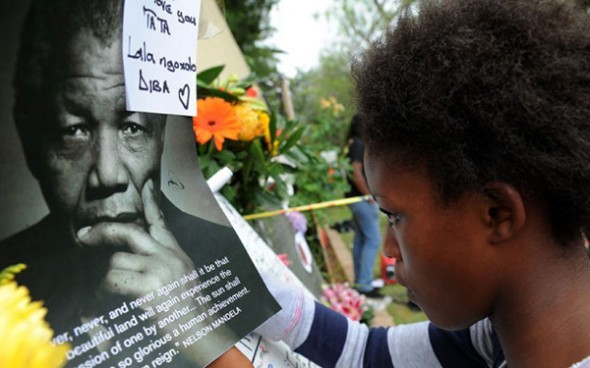
Remembering Mandela, one year on
On 5 December South Africa will mark one year since Nelson Mandela passed away in his Houghton home, after many months of ailing health. The world mourned his departure, having lost one of its greatest inspirations. US President Barack Obama said we should “pause and give thanks for the fact that Nelson Mandela lived”. The […]

On 5 December South Africa will mark one year since Nelson Mandela passed away in his Houghton home, after many months of ailing health. The world mourned his departure, having lost one of its greatest inspirations.
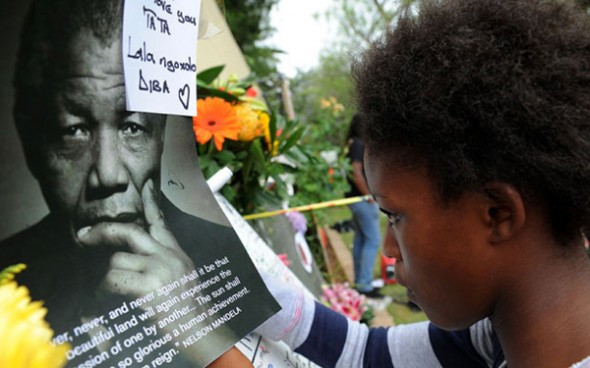
US President Barack Obama said we should “pause and give thanks for the fact that Nelson Mandela lived”. The then Prime Minister of Australia Kevin Rudd called Mandela the man of the century, while Bill Gates said his “grace and courage changed the world”.
World leaders and celebrities flew to South Africa to attend his funeral in Qunu and the memorial service at FNB Stadium in Johannesburg. They mourned his departure, but also celebrated the 95 remarkable years he had lived.
After spending 27 years in apartheid’s prisons, Mandela became South Africa’s first democratically elected president in 1994. He united a fraught and fearful country, bringing together blacks and whites when South Africa was a violent and troubled country. His legacy is enormous. For 27 years he was South Africa’s icon of freedom, even though apartheid law made displaying his image illegal.
At the end of his presidency he continued to work for a better South Africa, mainly through his many foundations. These include the Nelson Mandela Foundation, the Nelson Mandela Children’s Fund, the Nelson Mandela Centre of Memory, and, in his home province of the Eastern Cape, the Nelson Mandela School of Science and Technology, which opened in January this year. Mandela’s name – and prison number – are also used in the 46664 campaign, a worldwide concert fundraising programme to help victims and orphans of Aids.
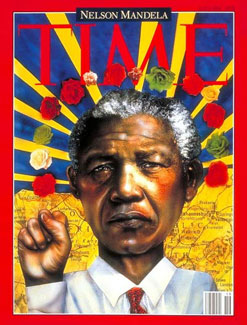
(Image: Time)
Troublemaker from the Eastern Cape
Nelson Rolihlahla Mandela was born on 18 July 1918 in Mvezo in the Eastern Cape province, the son of a chief of the Tembu clan of the Xhosa nation. At the age of seven he was enrolled in the local missionary school, where he was given the European name “Nelson” by a Methodist teacher who found his African name difficult to pronounce. That name, Rohlihlahla, means “troublemaker”.
After his father was stripped of his chieftainship following a dispute with a local magistrate, Mandela and his mother moved to the small village of Qunu. In 1927, when Mandela was nine, his father died, and the boy became the ward of the Tembu regent, Jongintaba Dalindyebo. He was to be groomed to assume high office but, influenced by the cases that came before the chief’s court, decided to become a lawyer.
In 1939, after he had matriculated from school, Mandela enrolled at the University College of Fort Hare for a bachelor of arts degree. But the following year, after being suspended from college for joining in a protest boycott and fleeing an arranged marriage, he moved to South Africa’s principal city, Johannesburg.
Arriving in Alexandra township in the north of the city, he found work as a guard at one of Johannesburg’s many gold mines, and later as an articled clerk at a law firm. He completed his degree by correspondence at the University of South Africa, and began to study law at the University of the Witwatersrand.
In 1942 Mandela entered politics by joining the African National Congress (ANC), South Africa’s major liberation movement and today the country’s ruling party. It was during this time that he and a small group of mainly young members of the ANC embarked on a mission to transform the party into a mass movement.
In 1944 he, Anton Lembede and Mandela’s lifelong friends and comrades Oliver Tambo and Walter Sisulu founded the ANC Youth League (ANCYL). That year he also married his first wife, Evelyn Mase. In 1947 he was elected president of the ANCYL.
The year 1948 was a dark one in South Africa, with the election of the racist National Party, voted into government by a white electorate on the platform of apartheid. In response, in 1949, the ANC adopted its Programme of Action, inspired by the Youth League, which advocated the weapons of boycott, strike, civil disobedience and non-cooperation with authority.
The programme aimed at the attainment of full citizenship and direct parliamentary representation for all South Africans. In policy documents co-written by Mandela, the ANCYL paid special attention to the redistribution of the land, trade union rights, free and compulsory education for all children, and mass education for adults.
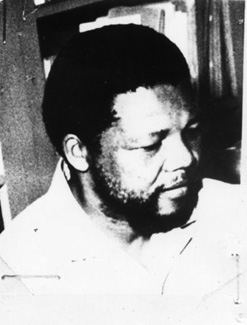
(Image: Historical Papers, University of the Witwatersrand)
During the Campaign for Defiance of Unjust Laws in 1952, Mandela was elected the ANC’s national volunteer-in-chief and travelled the country organising resistance to discriminatory laws. He was charged and brought to trial for his role in the campaign and given a suspended prison sentence.
Mandela and Tambo attorneys
In recognition of his contribution to the defiance campaign, Mandela was elected president of both the Youth League and the Transvaal region of the ANC at the end of 1952. He subsequently became the deputy president of the ANC.
Soon after the defiance campaign, Mandela passed his attorney’s admission examination and was admitted to the profession. In 1952 he and Oliver Tambo opened a law firm in downtown Johannesburg.
Tambo, the chairperson of the ANC at the time of his death in April 1993, wrote of their practice: “To reach our desks each morning Nelson and I ran the gauntlet of patient queues of people overflowing from the chairs in the waiting room into the corridors … Our buff office files carried thousands of these stories and if, when we started our law partnership, we had not been rebels against apartheid, our experiences in our offices would have remedied the deficiency. We had risen to professional status in our community, but every case in court, every visit to the prisons to interview clients, reminded us of the humiliation and suffering burning into our people.”
The 1950s turned out to be a time of strife and tribulation for Mandela – he was banned, arrested and imprisoned. His personal life was also in some turmoil, as he divorced Evelyn to marry Winnie Madikizela. He was also one of the accused in the historic Treason Trial that ended in 1961, with the state dropping all charges.
The Black Pimpernel
In 1960 police opened fire on a group of protesters in the township of Sharpeville, killing 69 people. The reaction was immediate, with demonstrations, protest marches, strikes and riots across South Africa. On March 30 1960, the government declared a state of emergency, detaining more than 18 000 people, and banning the ANC and other liberation movements.
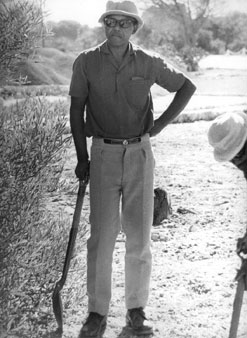
(Image: National Archives, courtesy Nelson Mandela Foundation)
With the banning, the ANC leadership went underground and Mandela was forced to live away from his family. He was a master of disguise and managed to evade the police, a feat which earned him the nickname in the media as the Black Pimpernel.
The banning also forced the ANC to move from nonviolent to violent means of opposing apartheid. Umkhonto we Sizwe, the movement’s armed wing, was formed in 1961, with Mandela as commander-in-chief. After travelling abroad for several months, he was arrested in 1962 on his return to South Africa for unlawfully exiting the country and for incitement to strike. Convicted, he was sentenced to five years on Robben Island, the notorious political prison off the coast near Cape Town.
While serving this sentence, he was charged with sabotage in the infamous Rivonia Trial. In 1964 Mandela was sentenced to life imprisonment.
Eighteen of Mandela’s 27 years in jail were spent on Robben Island, where he carried out hard labour in a lime quarry. As a D-group prisoner, the lowest classification, he was allowed only one visitor and one letter every six months.
While in prison Mandela studied by correspondence with the University of London, earning a Bachelor of Laws degree. In 1984 he was transferred to Pollsmoor Prison in Cape Town, and in December of that year he was moved to Victor Verster Prison near Paarl in the Western Cape.
President of South Africa
Over the years, South Africa slowly descended into near-chaos, with almost constant unrest inside the country, armed insurgency from without, and steadily increasing international pressure from the international community to end apartheid. On 2 February 1990 the country’s National Party president, FW de Klerk, made a remarkable announcement: a negotiated settlement would end apartheid, all liberation movements would be unbanned, and all political prisoners released – including Nelson Mandela.
Nine days later Mandela walked out of Victor Verster prison, his wife Winnie on his arm and his fist raised in the liberation movement salute.
In 1991, at the first national conference of the ANC held inside South Africa after its decades-long banning, Mandela was elected president of the party. His long-time friend, Tambo, became national chairperson. In 1993 he and FW de Klerk were awarded the Nobel Peace Prize for their different roles in the peaceful end of apartheid.
In 1994, after South Africa’s first democratic elections, Mandela became president of the Republic of South Africa. That year he published his autobiography, Long Walk to Freedom, which he started writing in prison.
After serving a five-year term as president of the country, Mandela ceded the ANC presidency to Thabo Mbeki. He retired from public life in June 1999, though not from the public eye. He built himself a home in his birthplace in Qunu, which he would visit as often as he can.
Friendships
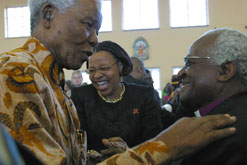
(Image: Hope Foundation)
Known affectionately by his clan name of Madiba, Mandela had friends across the world – Bill Clinton, Bono of U2, Naomi Campbell. Some of his friendships went back over 60 years, as with Walter Sisulu, Oliver Tambo and Ahmed Kathrada.
In his autobiography Memoirs, Kathrada recounted that he and Mandela affectionately called one another madala, isiZulu for old man.
“Charming and charismatic, he has both a magnetic personality and a commanding presence,” Kathrada wrote. “An uncommon amalgam of peasant and aristocrat, he is a living paradox: a democrat par excellence, with just a touch of the autocrat; at once proud but simple; soft yet tenacious; obstinate and flexible; vain one moment and humble the next; infinitely tolerant but also impatient.”
Kathrada and Mandela spent 18 years together on Robben Island and a further seven in Pollsmoor Prison, along with Sisulu.
“For all the public exposure and media attention Madiba remains an enigma to all but his most intimate circle,” Kathrada said.
He recounted an incident with a terminally ill girl, Michelle Britz, that was typical of Mandela. She wanted to meet Madiba, and when she met Kathrada on Robben Island, he got to know of her wish. Kathrada passed on her wish to the then president, who sprang into action immediately.
“The president of South Africa, a universally respected statesman with one of the busiest schedules on earth, flew to the Mpumalanga town of Secunda by helicopter, bearing gifts for a sick child.
“The emotional meeting between Madiba and Michelle was shown on national television, and as she clasped her little arms around his neck and kissed him, the eyes of millions must have filled with tears, just as mine did.”
In his honour
Nelson Mandela was given the freedom of 45 cities around the world, and honorary citizenship of 11 cities.
In Johannesburg, his image was cast in a 6m-high bronze statue and stands preserved in his famous jive in Nelson Mandela Square.
Speaking at the statue’s unveiling in April 2004, Ndileka Mandela, Madiba’s eldest granddaughter, said: “This is a very happy statue. The dancing stance pays tribute to the spirit of joy and celebration inherent in the people of South Africa.”
The countless tributes to him around the world are without precedent. He had 23 schools, universities and institutions named after him; 25 halls, buildings, monuments and housing developments; 13 stadiums, squares, plazas, parks and gardens; 91 streets, roads, boulevards and parks; 32 bursaries and scholarships, foundations and lectures. Thirteen statues, sculptures and artworks carry his name.
From 1979 onwards, Madiba was awarded 76 degrees, including 42 doctorates, from universities in 30 countries of the world. That’s more than two degrees every year.
Madiba collected dozens of accolades from around the world: 18 sports-related honours and awards, and 115 other awards.
He had a range of strange items named after him: a landfill site, a spider, a sea-slug, a protea, a tea, an orchid, a rescue dog, and a racehorse.
Marriage, children and old age
Mandela and Winnie divorced in 1996. In 1998 he married Graça Machel, widow of Samora Machel, the president of Mozambique until his death in 1986.Their wedding anniversary was the same date as his birthday – 18 July. In a 2008 interview with Mike Hanna on the Al Jazeera television network, Machel described how lonely Mandela was when she first met him.
“After 27 years in jail, what he most longed for was not the glory of political life, but to have a family life,” she said. “It was a meeting of minds and a meeting of hearts.” Although she hadn’t wanted another marriage after Samora Machel’s death, she decided that her gift to Mandela on his 80th birthday would be to marry him.
“Madiba has allowed me to continue to be myself. He has always respected my space. We have a deep sense of sharing, but at the same time we respect each other’s identities.
“For a man of his age, a man who has gone through those kinds of experiences, he could have become extremely possessive. He’s not. Maybe that’s what love really means. We have found a balanced and respectful way of relating.”
Mandela outlived three of his six children, and only three of his daughters are still alive: Makaziwe, Zenani and Zindzi. He had 18 grandchildren, six great-grandchildren and three step-grandchildren, as well as four step-children from his marriage to Machel.
Towards the end of his life he and Machel spent their time in Qunu or at their home in the upmarket suburb of Houghton, in Johannesburg. His greatest pleasure of his old age, he said, was watching the sun set, with the music of Handel or Tchaikovsky playing in the background.
A short distance from the tranquil surrounds of Houghton, his famous words from the Rivonia Trial echo on the walls of the Drill Hall in central Johannesburg:
“I have fought against white domination, and I have fought against black domination. I have cherished the ideal of a democratic and free society in which all persons live together in harmony and with equal opportunities. It is an ideal for which I hope to live and to achieve. But if it needs be, it is an ideal for which I am prepared to die.”
Source:www.mediaclubsouthafrica.com
